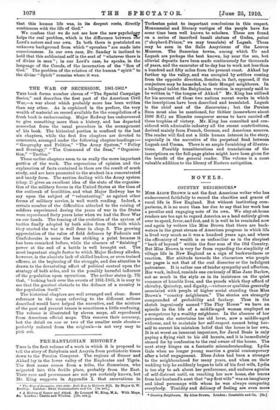PRE-BABYLONIAN HISTORY4
THIS is the first volume of a work in which it is proposed to tell the story of Babylonia and Assyria from prehistoric times down to the Persian Conquest. The regions of Sumer and Akkad lay in the lower valley of the Euphrates and Tigris. The first name comes from a tribe, the Sumerians, who migrated into this fertile place, probably from the East. Their race and provenance are not yet certainly known, but Mr. King suggests in Appendix I. that excavations in • The War of Secession, 1'x61-1889: Bull Bun to Malvern MIL By Major G. W. Body/ay. London ; Swan Sonnensehein and Co. [5s. net.] t A History of Sumer and Akkad. By Leonard W. King, M.A. With Maps, Ja London : Matto and Windas. netaj
Turkestan point to important conclusions in this respect Monumental and literary vestiges of the people have for some time been well known to scholars. These are found on a series of inscribed basalt statues of Gudea, paten: (" shepherd-Prince," we may translate) of Lagash. These may be seen in the Salle Assyrienno of the Louvre Museum. The Sumerian towns, among which Ur and Lagash are perhaps the best known, lay near the sea, but alluvial deposits have been made continuously for thousands of years, and the excavator of to-day has to work not less than a hundred and fifty miles from the present coast. Akkad lay further up the valley, and was occupied by settlers coming from the opposite direction, Semites, in fact, opposed, if the conjecture may be hazarded, to their Mongol neighbours. In a bilingual tablet the Babylonian version is expressly mid to be written in " the tongue of Akkad." Mr. King has utilised for his account of these two nations recent works in which the inscriptions have been described and translated. Lagash is the chief seat of the discoveries ; but the Persian Sum must also be mentioned, for thither (somewhere about 1500 B.C.) an Elamite conqueror seems to have carried off these trophies of victory. Mr. King has consulted and con- sidered with admirable industry all the recent contributions, derived mainly from French, German, and American sources. The reader will find not a little human interest in the story, especially in the narrative of the perpetual feud between Lagash and Umma. There is an ample furnishing of illustra- tions. Possibly transliterations and translations of the inscriptions on the full-page plates might have been given for the benefit of the general. reader. The volume is a most valuable addition to the library of Eastern antiquities.






















































 Previous page
Previous page